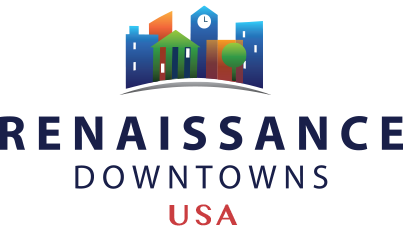RDUSA’s MUNICIPAL GRADING MATRIX
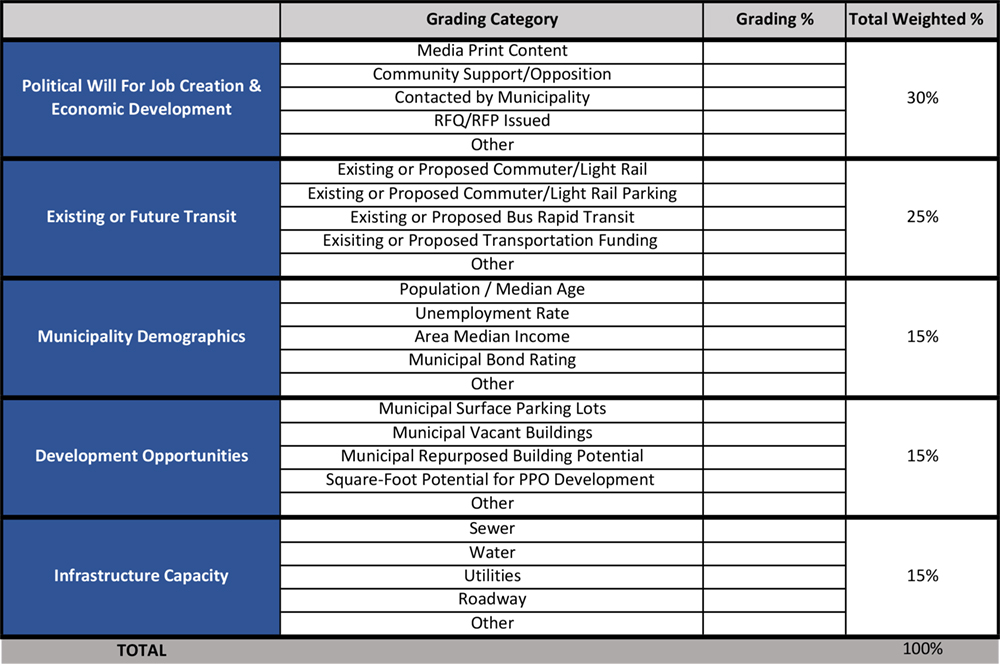
The total weighted percentages may vary from municipality to municipality.
RDUSA evaluates each municipal opportunity through an internal grading matrix process to assess the viability of each area studied in order to determine if a municipality meets a minimum threshold for Sustainable Impact Real Estate Development. This analysis helps to enable the RDUSA team to justify the level of human and financial capital commitments to each municipality.
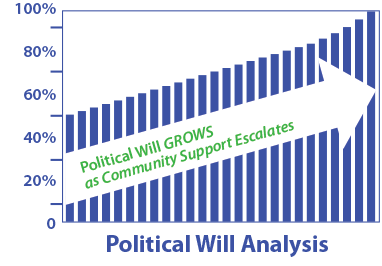
Our CORE REVITALIZATION METHODOLOGY
RDUSA’s Ecosystem
For an ecosystem to be sustainable all species must be included.
Renaissance Downtowns USA pioneers community-driven redevelopment of suburban downtowns located in proximity to major metropolitan areas throughout the country. RDUSA’s Triple-Bottom-Line vision focuses on socially, environmentally and economically responsible development utilizing a holistic and comprehensive approach.
![]()
The Starting Gate…
PROCESS Before PLAN
Renaissance Downtowns USA’s innovative approach for the co-creation of a shared development vision begins with a commitment to place Process Before Plan. All too often, the unveiling of a Plan prior to the introduction of the Process leads to community opposition that can result in the premature derailment of even a well-conceived project.
Conversely, the Process Before Plan approach enables a community to participate in the vital role of co-authorship through their early involvement in the Process which results in the co-creation of the Plan. Process Before Plan allows for the return of the “Art of Listening” which is essential to Renaissance’s Triple-Bottom-Line development approach.
Round 2
Selection of a
MASTER DEVELOPER
A suburban downtown redevelopment can only succeed if done in a holistic and comprehensive manner. An in-fill development approach has not and will not work to produce transformative suburban downtown redevelopment. In-fill development may work in major gateway cities since those are normally the only opportunities that exist for development in built-out urban centers. It’s impossible to think of re-inventing cities like New York, Los Angeles and Chicago.
However, what is needed in many suburban downtown communities is total re-activation of a central business district in order to create a walkable pedestrian-friendly environment where people can Live, Work, Shop, Learn and Play. This transformation can only be accomplished in a responsible manner and time-frame under the auspices of a Master Developer working collaboratively to co-author and help implement a shared vision with the community stakeholders and the municipality.

Create Urban Nodes in Suburbia (UNiS) through a Holistic & Comprehensive Development Strategy.
Partnerships Require:
SHARED VISION, CONFIDENCE, TRUST
THINKING BIG IS OFTEN BETTER AND EASIER!
Round 3
Crowdsourced Placemaking (CSPM)
Our “SECRET SAUCE”

Our “SECRET SAUCE” is Crowdsourced Placemaking (CSPM), a grassroots, bottom-up approach to community engagement. Proactive, inclusive and impactful community outreach enables city leaders to gauge the public reaction throughout the course of the revitalization process. Shortly after the designation by the municipality of a Master Developer, the community engagement process begins with the Master Developer immediately opening and supporting a community informational office staffed by local residents.
Stakeholders work together to launch a community-based portal, self-named by the stakeholders, enabling community members to join this collaborative process. Each community member is required to sign, either electronically or in person, a Triple-Bottom-Line agreement that the development ideas which they suggest must be socially, environmentally and economically responsible – difficult to argue with those rules. Once posted, the Master Developer will do a feasibility study on the largest vote-getters for the purpose of gauging the impact of these Triple-Bottom-Line development ideas.
Community – Opens Informational Office
Community – Self-Names
Community – Signs Triple-Bottom-Line Agreement
Community – Recruits Thousands of Participants
Community – Votes on Ideas Posted
Round 4
Unified Development Approach (UDA)
Revitalization Action Plan (RAP)
The Unified Development Approach (UDA) provides a framework that facilitates a comprehensive mixed-use and transit-oriented redevelopment strategy that brings together Community Stakeholders, Private Property Owners and Transit Agencies to collaboratively create and implement a shared, holistic redevelopment vision. This strategy helps to ensure project sustainability, thereby maximizing social, environmental and economic benefits as well as eliminating the need for eminent domain or displacement proceedings. This inclusive strategy creates an alignment between the Master Developer and Private Property Owners that would otherwise have resulted in the potential for competing interests.
The ongoing efforts of the CSPM process coupled with the UDA serves as a platform for the creation of a co-authored Revitalization Action Plan (RAP). The RAP enables the commencement of the Triple-Bottom-Line process analyzing the social, environmental and economic benefits.
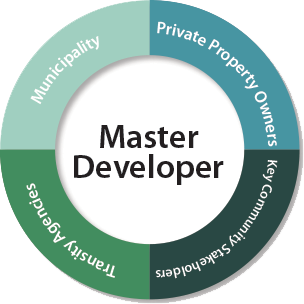
Round 5
Triple-Bottom-Line Analysis
Social Impact Investment (SII) is now being measured, and in many instances required, to fulfill Social Returns on Investment (SROI) mandates. It’s time to realize that “IF YOU DO GOOD, YOU’LL DO WELL.”
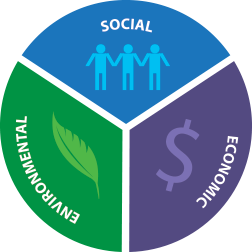
Social Responsibility Analysis
- Attainable Housing Analysis
- Social Impact & Equity Study
- Social Returns on Investment (SROI)
Environmental Responsibility Analysis
- Climate-Smart Development
- Healthy Land Use
- CEQA & tomorrow’s generation
Economic Responsibility Analysis
- Job Creation & Economic Development
- Sustainable fiscal outcomes
- Act now or pay later
Round 6
Form-Based Zoning
In order for a truly transformative suburban downtown redevelopment to occur in a reasonable time-frame, a community must be able to adapt to market cycles and preferences in a timely manner through the adoption of a Form-Based Zoning Code. In contrast, traditional “Conventional Zoning” completely negates the ability for communities, municipalities and developers to quickly adjust to future uncertainties that surely lie ahead.
A properly written Form-Based Zoning Code encourages property owners to aggregate their properties in order to participate and maximize their development opportunities. By working collaboratively under this overlay zone all stakeholders stand to benefit by participating in this inclusive process and realize the value created by the certainty resulting from the approval of sustainable entitlements.
Conventional Zoning (the “Old Norm”)
- Separation of uses
- Inability to react timely to market conditions
- Create live, work, shop, learn, play overlay district
- Ability to react timely to market conditions
Round 7
Community Benefits Agreement (CBA)
Baked into a community-driven Form-Based Zoning Code, should be provisions outlining the terms and conditions of a Community Benefits Agreement (CBA). This mandate ensures that residents and local businesses in communities targeted for redevelopment are given opportunities for construction jobs, contract awards and careers so that they can also participate in this newly created Live, Work, Shop, Learn and Play environment.
Our insistence on the inclusion of CBA’s are the hallmark of our continued commitment and serve as a further reassurance that “IF YOU DO GOOD, YOU’LL DO WELL.”
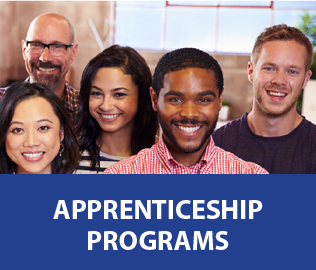
HIRING Mechanisms for Each Municipality
- Construction jobs
- Contracting opportunities
- Permanent jobs & careers
- Entrepreneurial Opportunities
Baked into the Zoning.
It’s now the Law.
The Finishing Line…
Groundbreaking

“What one might perceive as the end of RDUSA’s collaborative revitalization process in fact represents
a New Beginning.”
-Donald Monti, CEO Renaissance Downtowns USA
